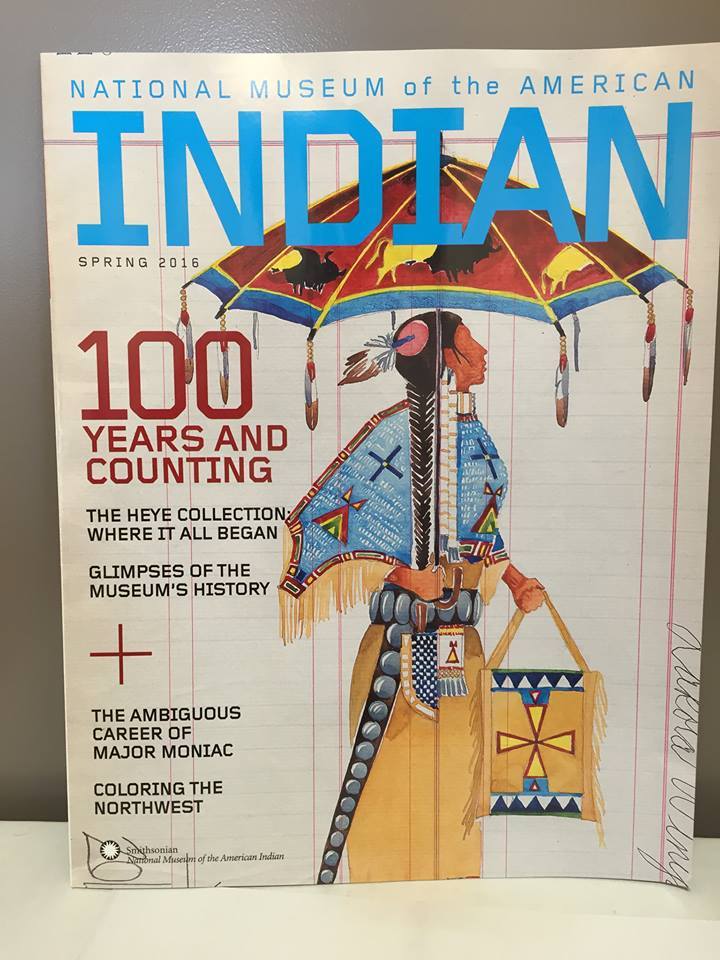
Joel Pulliam's ledger art is currently featured on the cover of the Smithsonian National Museum of the American Indian Magazine.Photo from Pine Ridge Center for Artists and Crafters / Facebook
Lakota Artist Graces Cover of Smithsonian Magazine
By Brandon Ecoffey
Lakota Country Times Editor
www.lakotacountrytimes.com PINE RIDGE-- One Lakota artist is beginning to reap the benefits of over twenty years of work having landed the cover of the Smithsonian National Museum of the American Indian Magazine. "One of the more prominent local artists actually discouraged me from pursuing a career as an artist," said Joel Pulliam, an Oglala Lakota artist from the Pine Ridge Indian Reservation. "He said I would never make any money or go anywhere with my work --but that isn't why I do my art anyway." He is one of sixteen Native American artists making up an exhibit at the Smithsonian's National Museum of the American Indian in New York City. “Unbound: Narrative Art of the Plains,” has been open since March and displays the work of the likes of Pulliam, Martin E. Red Bear, Dwayne Wilcox and Jim Yellowhawk. Pulliam has dedicated his work to preserving Lakota culture and his pieces are very similar to the earliest depictions of ledger art.

Renowned Lakota artist Joel Pulliam. Courtesy photo
"One of the earliest known pieces of ledger art was created by some Cheyenne warriors," said Pulliam. "They happened to come across a notebook on the trail. They put their warrior deeds over the writing. They were saying that 'my way of life is better than this way of life'. They were saying that the Wasicu way of life has nothing on their's." He says that when he recites this story he has gotten mixed reactions from crowds who have heard him speak, but for Pulliam authenticity and accuracy matter when it comes to ledger art. "I see it as a traditional art form and to keep it historically correct is something I value. I think it is something the original artists intended," said Pulliam. "They wanted to preserve the knowledge. They didn't realize the impact their work would have down the road and I hold that sacred. I think it is important to keep historical knowledge and maintain historical accuracy." According to the Smithsonian ledger art was a "medium first developed in the 1860’s by Plains Indian artists who drew or painted pictoral narratives on paper from accounting ledger books."

The National Museum of the American Indian in New York is hosting an exhibit -- "Unbound: Narrative Art of the Plains" -- that explores the narrative art tradition of tribes in the Great Plains. Photo by Joshua Stevens / NMAI
"Many of the earliest pieces of ledger art came army forts where Lakota artists were commissioned to do work for the soldiers," said Pulliam. The government issued paper that many pieces of ledger art are created on has become a distinct and coveted feature that collectors now demand. Pulliam says that part of the reason why discarded official documents were used as backgrounds for drawings is that there was a very limited amount of art supplies available to artists during the early years of the reservation era. Having been a graphic designer for over twenty years Pulliam was introduced to ledger art only nine years ago by Daniel Long Soldier. "Daniel Long Soldier was the ultimate mentor for me. He mentored me on everything from art history to art knowledge, and even provided encouragement for me when I needed it," said Pulliam. Once fully invested in ledger art, Joel would study the works of artists like Bad Heart Bull and others who he says, "Weren't making a living but were actually preserving a history." In his work he has tried produce art that captures authentic depictions of Lakota life so that it can be used as a teaching and motivational tool for youth and future generations.

Visit the Lakota Country Times and subscribe today
In an upcoming series intended to tell he story of modern Lakota life as well as point out some of the ironies within it, Pulliam plans to depict scenes that happen everyday on the Pine Ridge Indian Reservation. "I hope to have this series done by the Red Cloud Art Show," said Pulliam. " I have one piece that shows someone riding up to Big Bat's on horseback." Big Bat's is a local gas station in the center of Pine Ridge Village and it is common to see locals use a horse to transport them from home, to the store, and back. For more information on Joel's work you can visit his Facebook page. (Contact Brandon Ecoffey at editor@lakotacountrytimes.com) Find the award-winning Lakota Country Times on the Internet, Facebook and Twitter and download the new Lakota Country Times app today.
Join the Conversation